|
|
Post by Dietmar on Mar 21, 2013 8:52:02 GMT -5
George Catlin´s Comanche portraitsIn 1834, famous painter George Catlin was with an expedition of United States Dragoons, first under Colonel Henry Leavenworth, who died underway, and then under Henry Dodge. They met Comanches near the Wichita Mountains and Catlin had the opportunity to paint some portraits of their leaders. The question who was the principal leader is discussed in Dr. Tom´s “The Comanches – A History 1706-1875” (page 237-242). Despite Catlin´s account it possibly was Tabequena (Sun Eagle), misidentified by him as “Mountain of Rocks”. Another prominent chief was Esacony (Returning Wolf), Catlin´s first chief, whom he named “The Bow and Quiver” for some unknown reason. Of course, if Catlin managed to twist the names of the first two chiefs we have to be careful with the rest of the name translations as well: 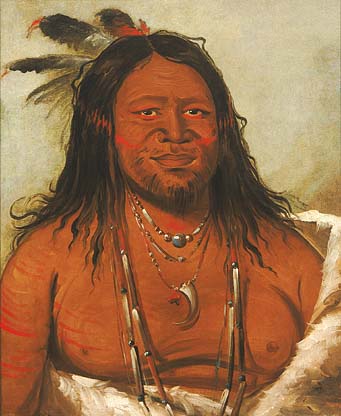 Ta-wáh-que-nah, or Mountain of Rocks [sic], Second Chief of the Comanches (according to Catlin) 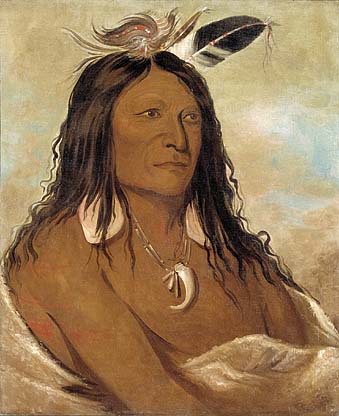 Eé-shah-kó-nee, Bow and Quiver [sic], first chief of the Comanches (according to Catlin) 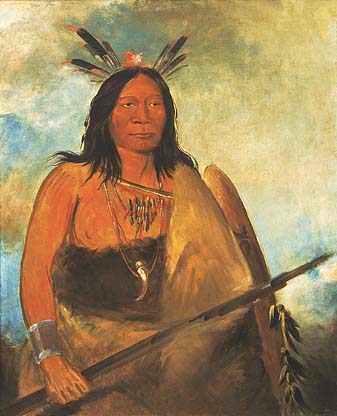 Kots-o-kó-ro-kó, Hair of the Bulls Neck, a Chief 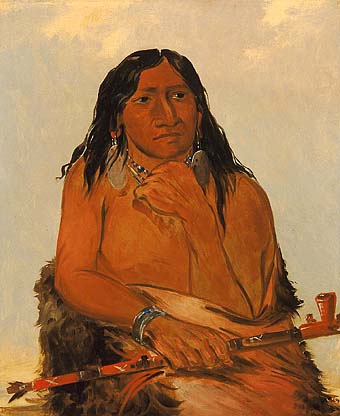 Is-sa-wáh-tám-ah, Wolf Tied with Hair, a Chief 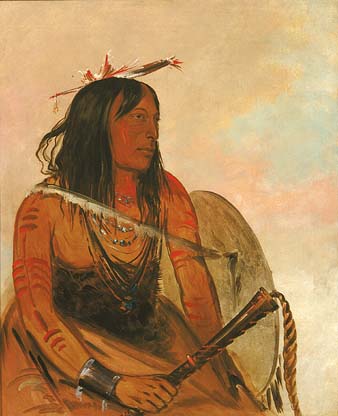 Ish-a-ró-yeh, He Who Carries a Wolf, a distinguished Brave 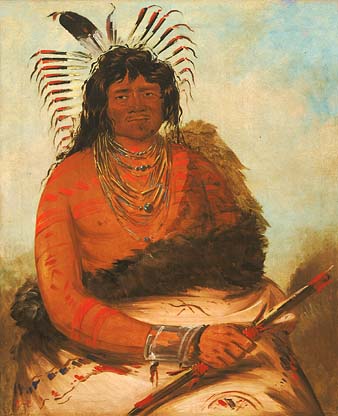 Háh-nee, The Beaver, a Warrior 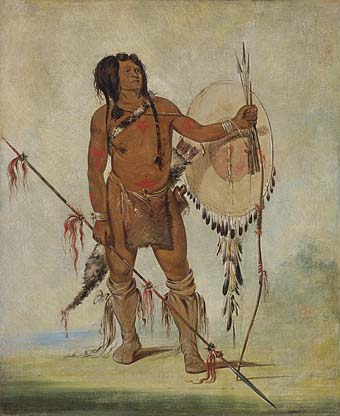 His-oo-sán-chees, The Little Spaniard The last Comanche, known as Little Spaniard by Catlin, was half Comanche/Mexican. His Spanish name was Jesus Sanchez. BTW, here´s an interesting article about Tabequena and his weighty figure: (is that you, Tom?) wutheringexpectations.blogspot.de/2009/12/how-to-miss-evidence-obese-comanche.htmlHow to miss (and see) evidence - the obese Comanche chiefs
Chief A Big Fat Fall by Tripping, it is told, owned fifteen hundred horses, but he was so fat that he could not ride any of them and had to be moved around on a travois. (The Comanche Empire, 259)
I want to discuss an example of how we (I) misunderstand evidence that is directly in front of us (me!), and how professional historians do their job.The Comanches may have been the greatest horsemen in American history. They culture was fundamentally mounted, as was much of their economy, which was based on a mix of seasonal buffalo hunting and raiding for horses, cattle, and humans. Wealth was often measured in horses. Yet they were also a trading nation. Meat, hides, horses, and slaves were traded for carbohydrates (squash and corn) and metal goods.
George Catlin, in Letter 42 of Letters and Notes of the Manners, Customs, and Condition of the North American Indians (1841), describes his meeting with "a huge mass of flesh," the Comanche chief Ta-wah-que-nah (The Mountain of Rocks - see left for Catlin's portrait). The chief "would undoubtedly weigh three hundred pounds or more," and was a "perfect personification of Jack Falstaff." Catlin is baffled by the man, since "[c]orpulency is a thing exceedingly rare to be found in any of the tribes, amongst the men."
Catlin paints Ta-wah-que-nah and moves on to the next portrait subject. Reading Catlin (a great book, by the way), I did the same thing.
I should have known better. Pekka Hämäläinen knew better. In fairness, he was aware of multiple examples of overweight Comanches, all from roughly the same time period, the peak of Comanche power. They are evidence, not anecdote. Hämäläinen calls these chiefs "the new elite men who led the Comanche society in the early nineteenth century." They became leaders because they were extraordinarily successful traders, not warriors. They were so rich that they could abandon core aspects of their culture yet maintain their status. These men were organizers, entrepreneurs, managing enormous households of slaves, wives, and affiliated herders and raiders, producing goods for the American market.
Their corpulence was a sign, just as it was in other contemporary societies, of their wealth - high calorie input, low energy output. These men are evidence of a profound change in Comanche society. Historians depend on witnesses like Catlin, who rarely penetrated past the edge of the Comanche Empire, and only saw disconnected fragments. With the help of anthropologists and demographers and ecologists, historians like Hämäläinen can reassemble the pieces.
Hämäläinen saw what was going on. Catlin and I missed it.
|
|
|
|
Post by Dietmar on Mar 22, 2013 9:02:57 GMT -5
from: Letters and notes on the manners, customs, and condition of the North American Indian by George Catlin, Vol. II, New York 1844, page 66 - 69: " The head chief of this village, who is represented to us here, as the head of the nation, is a mild and pleasant looking gentleman, without anything striking or peculiar in his looks (PLATE 168) ; dressed in a very humble manner, with very few ornaments upon him, and his hair carelessly falling about his face, and over his shoulders. The name of this chief is Ee-shahko-nee (the bow and quiver). The only ornaments to be seen about him were a couple of beautiful shells worn in his ears, and a boar's tusk attached to his neck, and worn on his breast.
For several days after we arrived at this place, there was a huge mass of flesh (PLATE 169), Ta-wah-que-nah (the mountain of rocks), who was put forward as head chief of the tribe ; and all honours were being paid to him by the regiment of dragoons, until the above-mentioned chief arrived from the country, where it seems he was leading a war-party ; and had been sent for, no doubt, on the occasion. When he arrived, this huge monster, who is the largest and fattest Indian I ever saw, stepped quite into the background, giving way to this admitted chief, who seemed to have the confidence and respect of the whole tribe.
This enormous man, whose flesh would undoubtedly weigh three hundred pounds or more, took the most wonderful strides in the exercise of his temporary authority; which, in all probability, he was lawfully exercising in the absence of his superior, as second chief of the tribe.
A perfect personation of Jack Falstaff, in size and in figure, with an African face, and a beard on his chin of two or three inches in length. His name, he tells me, he got from having conducted a large, party of Camanchees through a secret and subterraneous passage, entirely through the mountain of granite rocks, which lies back of their village; thereby-saving their lives from their more powerful enemy, who had " cornered them up" in such a way, that there was no other possible mode for their escape. The mountain under which he conducted them, is called Ta-wah-que-nak (the mountain of rocks), and from this he has received his name, which would certainly have been far more appropriate if it had been a mountain of flesh.
Corpulency is a thing exceedingly rare to be found in any of the tribes, amongst the men, owing, probably, to the exposed and active sort of lives they lead ; and that in the absence of all the spices of life, many of which have their effect in producing this disgusting, as well as unhandy and awkward extravagance in civilized society.
Ish-a-ro-yeh (he who carries a wolf, PLATE 170) ; and Is-sa-wah-tam-ah (the wolf tied with hair, PLATE 171) ; are also chiefs of some standing in the tribe, and evidently men of great influence, as they were put forward by the head chiefs, for their likenesses to be painted in turn, after their own. The first of the two seemed to be the leader of the war-party which we met, and of which I have spoken ; and in escorting us to their village, this man took the lead and piloted us the whole way, in consequence of which Colonel Dodge presented him a very fine gun.
His-oo-san-ches (the Spaniard, PLATE 172), a gallant little fellow, is represented to us as one of the leading warriors of the tribe ; and no doubt is one of the most extraordinary men at present living in these regions.
He is half Spanish, and being a half-breed, for whom they generally hare the most contemptuous feelings, he has been all his life thrown into the front of battle and danger ; at which posts he has signalized himself, and commanded the highest admiration and respect of the tribe, for his daring and adventurous career. This is the man of whom I have before spoken, who dashed out so boldly from the war-party, and came to us with the white flag raised on the point of his lance, and of whom I have made a sketch in PLATB 157. I have here represented him as he stood for me, with his shield on his arm, with his quiver slung, and his lance of fourteen feet in length in his right hand. This extraordinary little man, whose figure was light, seemed to be all bone and muscle, and exhibited immense power, by the curve of the bones in his legs and his arms. We had many exhibitions of his extraordinary strength, as well as agility ; and of his gentlemanly politeness and friendship, we had as frequent evidences. As an instance of this, I will recitó an occurrence which took place but a few days since, when we were moving our encampment to a more desirable ground on another side of their village. We had a deep and powerful stream to ford, when we had several men who were sick, and obliged to be carried on litters. My friend " Joe" and I came up in the rear of the regiment, where the litters with the sick were passing, and we found this little fellow up to his chin in the muddy water, wading and carrying one end of each litter on his head, as they were in turn, passed over. After they -had all passed, this gallant little fellow beckoned to me to dismount, and take a seat on his shoulders, which I declined ; preferring to stick to my horse's back, which I did, as he took it by the bridle and conducted it through the shallowest ford. When 1 was across, I took from my belt a handsome knife and presented it to him, which seemed to please him very much.
Besides the above-named chiefs and warriors, I painted the portrait of Kots-o-ko-To-ho (the hair of the bull's neck) ; and Hah-nee (the beaver) , the first, a chief, and the second, a warrior of terrible aspect, and also of considerable distinction. These and many other paintings, as well as manufactures from this tribe, may be always seen in my MUSEUM, if I have the good luck to get them safe home from this wild and remote region.
From what I have already seen of the Camanchees, I am fully convinced that they are a numerous and very powerful tribe, and quite equal in numbers and prowess, to the accounts generally given of them."
|
|
|
|
Post by tkavanagh on Jul 25, 2013 11:54:41 GMT -5
Re: Catlin’s Names:
Isakoni given as 'Bow and Quiver' it is 'Returning Wolf'
Tawahquena " ‘Mtn of Rocks' " 'Sun Eagle' (i.e., Golden Eagle)
Isaroyeh " ‘Carries a Wolf' " 'Wolf Mountain'
Kotsokoroko " ‘Hair of Buffalo" " 'Buffalo Necklace’
Isawahtamah " 'Wolf tied w/ Hair' " 'Wolf Teeth'
Hahnee " ‘Beaver " ‘ beaver
His soo san ches " ‘Little Spaniard’ " Jesus Sanchez
While we’re at it, from wutheringexpectations.blogspot.de/2009/12/how-to-miss-evidence-obese-comanche.html, going on and on about how that unimpeachable [!] source, Comanche Empire, “got things right”:
“Chief A Big Fat Fall by Tripping, it is told, owned fifteen hundred horses, but he was so fat that he could not ride any of them and had to be moved around on a travois. (The Comanche Empire, 259)”
As Pekka should have known from reading Com Pol Hist [he ‘borrowed’ so much else from it],
there was no historical person with any name close to this. The only references to this person are from the 1933 Field Party. [I’m on the road, so I won’t try to summarized them here.]
Pekka even got the name wrong: “Big Fat Fall by Tripping.” The name, Piarûpsima, is clear: Big Fall by Tripping. There is no ‘fat’ [‘yuhu’] in it at all.
This is a mythic personage, not in the sense of just fictional, but being held up as an example, and a bad example at that: (his own size is irrelevant) he should not have hoarded, and then attempted to kill, all those horses, but should have given them away while he was alive.
tk
Esimotsoraivo
|
|
|
|
Post by tkavanagh on Aug 11, 2013 17:33:48 GMT -5
Ok, here is the story:
The name the 1933 Comanche Field Party transcribed as Piarupsima -- etymologically, /pia/ ‘big’, /tupeheru/ ‘to fall off', /si/ ‘with the foot’, /ma/ completive suffix -- and translated as Big Fall By Tripping, is given by Hämaläinen as 'Chief Big Fat Fall by Tripping.' However, there is no indication in the name of the size of the person. e.g. Fat. Hamalainene's, and with it wutheringeexpectation's, edifice falls flat on it's face.
While we're at it: here is the entirety of the 1933 Field Party's information on 'Big Fall':
Nemaruibitsi Aug 1
Life Cycle: Death: Disposition of Property Piarûpsima, Big Fall by Tripping, had lots of property, particularly horses. When he died, they rounded up his stock; his nephew [ara] rounded them up. He had in mind to kill all the horses [the wild ones]. He was killing horses right and left, when four [dis-interested] men came up and said, “You mustn’t kill all of them. You have children and friends. Give them to your children and maybe to your friends.”
So the nephew gave horses to all of his friends and saved some for his children.
The uncle had left two wives. Before the nephew began killing their horses, he picked ten of the gentlest, five for each widow. There were no children. If there had been, they would have taken charge.
Howard White Wolf Aug 3
Life Cycle: Death: Disposition of Property In the old days, when a person died, they killed as many horses as they could, and left the rest to the widow.
When Piarûpsima died, his widow could get no help in moving the body [Wallace and Hoebel(1952:40)?], so he was buried in the tipi, and when they moved they left the tipi standing. This was an unusual thing.
Property went to the widow, and perhaps the children might get a share.
Teneverka Undated
Life Cycle: Death: Disposition of Property Piarûpsima had about three thousand horses [Wallace and Hoebel (1952:39) has “1,500 horses at the time of his death.”]; he had no relatives but his wife. He told the tribe that on his death he wanted each of his three hundred arrows to kill one of his best horses. No one should have his best horses.
He had three quivers of one hundred arrows each. The rest of the horses should be divided among the tribe. He died and was buried inside a hole in his tipi. The tipi was left standing over him. His wife moved out.
The next day the paraibo called for the best marksmen to kill his horses with those three hundred arrows. The remainder were divided among the tribe.
Esasûmû, a Kiowa Chief, knew of Piarûpsima’s case. He built his house right over Piarûpsima’s tipi, the place where he was buried.
Every night a ghost would come and knock on the windows and doors. Someone would get sick.
Esasûmû went to Piarûpsima’s grave. He said he didn’t come to show he was greater, he just liked the place. He said he might talk it over, “Come and tell me.”
That night there came a knocking on the door. He said he talked it over with his wife, and he decided to dig up the grave. He did so, put the remains in a casket in the cemetery. They were all right after that. Piarûpsima didn’t like being tramped on.
Note that these give no indication of his social status, e.g., Chief. Pekka made it up.
Note also that ‘Esasûmû’, literally ’one wolf’ in Comanche, is better known in English as ‘Lone Wolf’; in Kiowa, Guipago. There were several Kiowa men with this name, sons, or step-sons of the antecedent. The first Lone Wolf (as far as we know) died in 1879, so this story probably refers to the second, also known as ‘Derby’ Lone Wolf. Both this, and the story of his placement of his house over Big Fall’s grave, imply that these events took place on the Reservation, after 1875. This is extremely unlikely:
-no one Comanche could have owned that many horses on the reservation [remember, McKenzie shot that many after Palo Duro];
-there is no one by that or similar name on the Reservation census lists, nor anyone listed as “‘Big Fall’s’ Widow.”
To go from this bit unsubstantiated folk tale to major inferences on Comanche body image is bad historiography at it worst.
tk
Esimotsoraivo
|
|
fernando
New Member
 My birthday December 19, 1948
My birthday December 19, 1948
Posts: 12 
|
Post by fernando on Sept 17, 2016 10:39:22 GMT -5
A question for you T. Kavanagh on "the little spaniard" whose portrait is seen uphere. According to Stanley Noyes book "Los Comanches: the horse people 1751-1845" during the days of Camp Holmes Treaty August 1835 with Comanche and Wichita (dragoons and Catlin were there too), the Comanche Jesus Sanchez (by his mexican name)was,not without doubts,recognized as the official Comanche representative at the treaty. I have always admired the stories and portrait of Catlin about this robust and vigurous little warrior. Do you know anything more about him? I never came accross any other piece of news about him or his whereabouts.
pd. hope to be able to read, as soon as I receive your book "the Comanches: a history..."
Many tks in advance for your reply.
|
|
|
|
Post by tkavanagh on Sept 20, 2016 6:47:30 GMT -5
Please pardon the delay, I've been in Ireland.
Unfortunately, there are but few additional points that can be made about Jesus Sanchez.
-According to Joe A [personal communication], his Comanche name may have been ‘Seguitotori’ (as given by Wilbur Nye)— /sekwipû/ ‘mud’, with possibly /tohto¿itû/ ‘they exit forcibly’.
-In his dissertation study of Comanche captives, Joaquin Rivaya Martinez could not identify him by place of origin
[From _The Comanches_:
During the meeting with the Dragoons, Tabaquena reported that a group of Mexican traders had recently departed; Dodge seized the occasion to argue that Americans would give better goods and better prices and that they should come to Fort Gibson, and possibly even to Washington, for a treaty. That ended the official meeting. Several Comanches, a group of recently arrived Kiowas, and a number of Wichitas and Wacos, returned to Fort Gibson with the troops. Most of the Comanches turned back when one of the women fell sick, but The Spaniard accompanied the dragoons back to Fort Gibson. ...
At Fort Gibson the delegation of Plains Indians met in council with representatives of the immigrant tribes, Cherokees, Choctaws, Creeks, and Senecas, as well the local Osages. There was some discussion about the propriety of recognizing The Spaniard as a Comanche representative, and after initial suspicion on all sides, a general consensus emerged. Colonel Dodge and Western Superintendent Francis Armstrong made symbolic presents, including flags and medals, to the visiting westerners, and the eastern Indians gave them white beads and tobacco:
“The white beads are an emblem of peace and purity. . . . When you smoke the tobacco of friendship, all evil will go off with the smoke. . . . The beads and tobacco, you must take home to your people . . . tell them, “The beads show the road is clean,” and let them smoke the tobacco in remembrance of us who send it. . . . These white beads are the white path that leads from your door to our door.” (Foreman 1933:134–36)
There is apparently no further mention of Sanchez in the literature.
As an aside, the meeting at Ft Gibson was the first of many formal political interactions between Comanches and the removed Easterners, culminating in the Okmulgee General Councils of Indian Territory, 1871-78.
tk
|
|
















